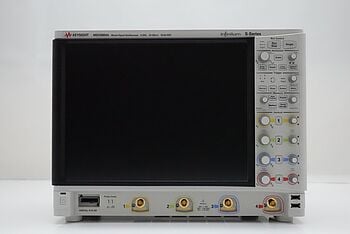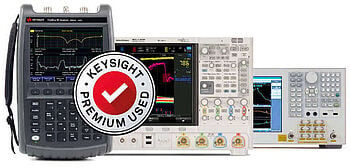- Introduction
- Definition of Sweep
- Components Involved
- Certified Refurbished Oscilloscopes On Sale Now
- Types of Sweeps
- Auto Sweep
- Normal Sweep
- Single Sweep
- Parameters Affecting Sweep
- The Importance of Sweep in Measurements
- Ensures Accurate Time Domain Analysis
- Facilitates Real-time Analysis
- Critical for Transient Analysis
- Best Practices for Setting Up Sweep
- Conclusion
- Whenever You’re Ready, Here Are 5 Ways We Can Help You
Imagine trying to capture a lightning strike using a regular camera; by the time you press the shutter, the moment is gone.
Just like a high-speed camera can freeze the split-second majesty of a lightning strike, the sweep function in an oscilloscope allows you to capture and analyze fleeting electrical signals in real time.
Mastering the concept and functionality of sweep is essential for any electrical engineer aiming for precise, insightful measurements.
In this article, we'll dissect what a sweep is, delve into its various types, and discuss its critical importance in modern oscilloscopes.
Definition of Sweep
A sweep in an oscilloscope refers to the horizontal movement of the electron beam across the display screen. This horizontal motion effectively draws the waveform of the electrical signal under observation.
Components Involved
- Timebase generator: Generates the timing signal for the sweep.
- Horizontal amplifier: Amplifies the timing signal.
- Electron beam (analog oscilloscopes): Physically moves across the cathode ray tube or manipulates the display in digital oscilloscopes.
| Key Takeaway |
|---|
| Mastering the sweep function in an oscilloscope is crucial for capturing and analyzing electrical signals accurately. The right sweep setting not only ensures precise time-domain measurements but also enables real-time analysis and effective transient event capture, making it indispensable in diverse engineering applications. |
Certified Refurbished Oscilloscopes On Sale Now
Types of Sweeps
Modern oscilloscopes offer a plethora of sweep types to cater to diverse applications and scenarios. From displaying erratic, unstable signals to capturing single, non-repetitive events, each sweep type has its own set of advantages and limitations.
Below, we take an in-depth look at the three primary types: Auto sweep, normal sweep, and single sweep.
Auto Sweep
Auto sweep mode comes with a built-in flexibility that automatically adjusts the trigger level. This ensures that even if a stable trigger condition is not met, the oscilloscope will still initiate the sweep.
This mode proves highly effective when dealing with unstable or unpredictable signals. Engineers often use auto sweep when analyzing noise or when the signal characteristics are not well known.
Advantages
- Stable display: Guarantees a visible waveform even when the signal is unstable.
- Ease of use: Ideal for quick observations where precise triggering is not necessary.
Limitations
- Reduced precision: May not accurately represent the waveform if it frequently deviates from the set trigger conditions.
Normal Sweep
In normal sweep mode, the oscilloscope waits for the incoming signal to meet or exceed a predefined trigger level before initiating the sweep.
Normal sweep is best suited for signals that are stable and periodic. Applications may include viewing clock signals or sinusoidal waveforms from a signal generator.
Advantages
- High precision: Captures precise waveforms with well-defined trigger conditions.
- Better analysis: Enables users to make exact measurements related to time and amplitude.
Limitations
- No display for unmet conditions: The oscilloscope screen may remain blank if the incoming signal does not meet the trigger conditions.
Single Sweep
In single sweep mode, the oscilloscope triggers the sweep once the signal reaches the trigger level and then stops, essentially capturing a "snapshot" of the waveform.
This mode is invaluable when you need to capture single, non-repetitive events, such as a transient spike or a one-time signal pulse.
Advantages
- Transient capture: Ideal for capturing and closely analyzing transient phenomena.
- Event isolation: Allows users to isolate and study specific events within a complex signal.
Limitations
- One-time use: After triggering, the oscilloscope must be manually reset to capture another event.
- Missed events: If not properly configured, it is possible to miss capturing the desired event entirely.
By selecting the sweep type that best matches your needs, you can optimize your oscilloscope for specific tasks, whether you are probing for abnormalities in a circuit or analyzing intricate waveform details.

Parameters Affecting Sweep
| Parameter | Impact on Sweep | Example |
|---|---|---|
| Sweep Speed | Determines how fast the electron beam moves. | Measured in s/div |
| Trigger Level | Sets the voltage level to initiate the sweep. | Adjustable in volts |
| Trigger Source | Specifies the source of the trigger signal. | Internal or external |
| Horizontal Scale | Influences the granularity of the displayed data. | Zoom in/out features |
The Importance of Sweep in Measurements
Ensures Accurate Time Domain Analysis
The sweep function provides the horizontal time axis, serving as the backbone for all time-related measurements. Accurate sweep settings are essential for calculating key waveform parameters such as frequency and period.
For instance, by observing how many divisions a single cycle of a waveform spans on the oscilloscope, and knowing the time per division setting, engineers can accurately calculate the frequency of the signal.
This enables them to verify if the circuit or system under observation is operating within desired parameters.
Without a well-calibrated sweep, such precise time-domain analyses would be fraught with errors, leading to incorrect diagnostics and ineffective solutions.
Facilitates Real-time Analysis
Real-time sweeps open the doors to dynamic system analysis. Unlike a single snapshot, a real-time sweep enables you to monitor ongoing changes in the signal.
This becomes particularly essential when you are debugging or monitoring live systems, such as real-time control systems or communication links.
With a real-time sweep, you can detect anomalies as they happen and take immediate corrective actions, avoiding potential system failures or inefficiencies.
Therefore, mastering real-time sweeps equips engineers with the tools needed to ensure the smooth operation of complex electrical systems.
Critical for Transient Analysis
The ability to capture non-repetitive or transient events can often be the linchpin for effective diagnostic procedures.
Single sweeps allow you to isolate and scrutinize these transient phenomena, from quick voltage spikes to random noise bursts.
With single sweeps, engineers can analyze how systems respond to sudden changes, such as electrical surges or load shifts, and make informed decisions on required countermeasures like surge protectors or filter circuits.
This level of detail is especially vital in sectors like automotive and aerospace, where understanding transient behaviors can mean the difference between optimal performance and catastrophic failure.
The sweep function is far from a simple setting; it is a critical feature that shapes how engineers interact with electrical phenomena.
From ensuring accurate time-domain analyses and facilitating real-time monitoring to enabling the critical evaluation of transient events, the sweep settings in an oscilloscope are pivotal for high-precision, insightful measurements.
Best Practices for Setting Up Sweep
After understanding what a sweep is and its significance in oscilloscope measurements, the next logical step is to dive into the best practices for setting up the sweep.
In this section, we'll provide practical tips and guidelines that can help you make the most of this critical function.
These best practices will enable you to optimize sweep settings based on different scenarios, whether you are dealing with complex waveforms, debugging circuits, or analyzing transient events.
- Understand Your Signal First
Before tweaking any settings, take the time to understand the nature of the signal you intend to measure. Is it periodic or non-periodic? Stable or erratic? Having a good grasp of your signal's characteristics will guide you in selecting the most appropriate sweep type. - Start with Auto Sweep for Unfamiliar Signals
If you are dealing with an unfamiliar or unstable signal, it's wise to start with the auto sweep setting. This mode will ensure that you get a stable display, giving you a starting point for your analysis. Once you've got an initial look at your signal, you can switch to other sweep modes for more detailed examinations. - Use Normal Sweep for Stable, Periodic Signals
For signals that are stable and periodic, normal sweep usually offers the most precise view. Since this mode waits for the signal to meet predefined trigger conditions, it can provide a very accurate representation of your waveform. This is particularly useful when you want to measure the frequency or any other time-dependent characteristic of the signal. - Employ Single Sweep for One-Time Events
When you need to capture a non-recurring event, such as a transient or a spike, use the single sweep mode. Make sure to set your trigger conditions carefully to capture the event accurately. It may take a few attempts to configure the oscilloscope appropriately. - Fine-Tune Trigger Settings
Regardless of the sweep type you choose, fine-tuning the trigger settings is crucial for accurate measurements. Adjust the trigger level and select the appropriate trigger source to match the particularities of your signal. - Verify Timebase and Horizontal Scale
The sweep speed or timebase setting significantly affects how much of the signal you can observe at one time. Make sure to adjust this according to the frequency and nature of your signal. Similarly, the horizontal scale can be zoomed in or out to examine the waveform with varying degrees of detail. - Continuously Monitor and Adjust
As you work through your measurements or debugging tasks, keep a close eye on the displayed waveform and adjust your sweep settings as needed. Sometimes slight changes in the signal characteristics can necessitate a reconfiguration of your sweep settings.
By following these best practices, you can navigate through various measurement challenges with ease, ensuring that your oscilloscope functions as a versatile, reliable tool for all your signal analysis needs.
Ready to Find The Perfect Oscilloscope?
Conclusion
Understanding and effectively using the sweep function is a cornerstone skill for any electrical engineer or technician working with oscilloscopes.
It's not merely a setting to tweak; it's a pivotal feature that impacts the accuracy and depth of your measurements.
Whether you're involved in time-domain analysis, real-time monitoring, or transient event capture, the sweep settings are your gateway to insightful, high-precision measurements.
If you're in the market for top-notch oscilloscopes or other test and measurement equipment, look no further than the Keysight Used Equipment Store.
Offering premium used oscilloscopes, spectrum analyzers, waveform generators, and multimeters, Keysight ensures you get reliable, high-quality equipment without breaking the bank.
Take your measurements to the next level by investing in Keysight equipment today.

Whenever You’re Ready, Here Are 5 Ways We Can Help You
- Browse our Premium Used Oscilloscopes.
- Call tech support US: +1 800 829-4444
Press #, then 2. Hours: 7 am – 5 pm MT, Mon– Fri - Talk to our sales support team by clicking the icon (bottom right corner) on every offer page
- Create an account to get price alerts and access to exclusive waitlists.
- Talk to your account manager about your specific needs.

































































































